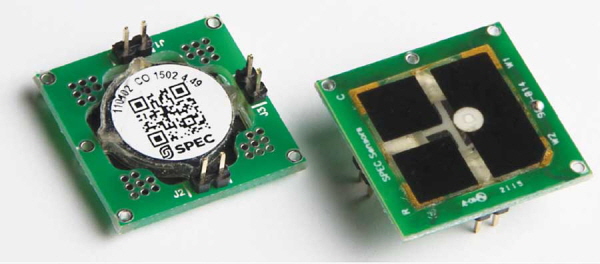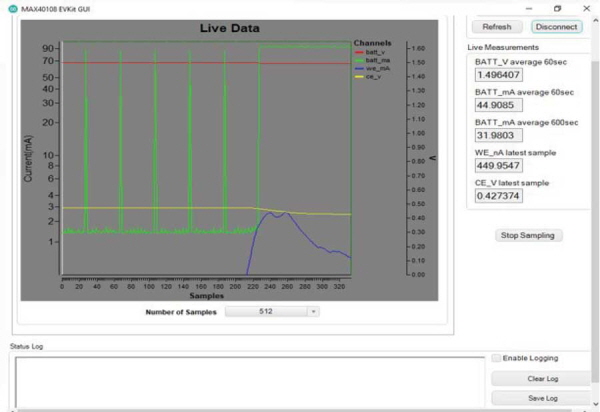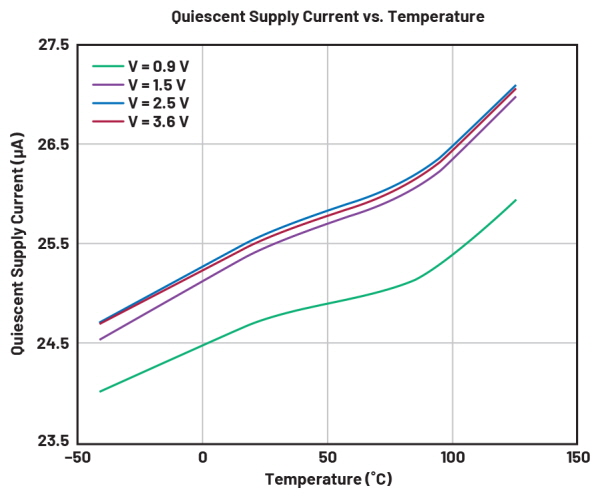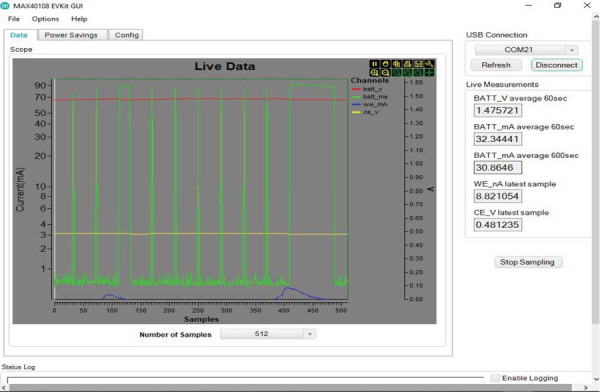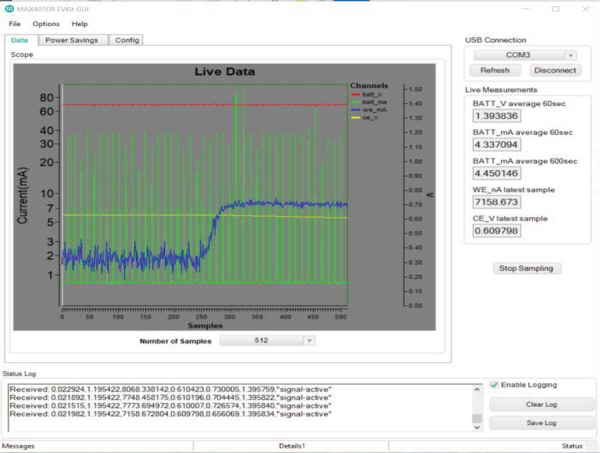“에탄올·CO 정밀측정, 저전력·고정밀 연산 증폭기 必”
MAX40108, 25.5A 낮은 전류 소모·작은 크기 특징
웨어러블·휴대용 의료기기·산업용 IoT 사용에 적합
이 글에서는 에탄올이나 일산화탄소(CO) 같은 기체를 감지하기 위한 전기화학식 기체 센서용 연산 증폭기에 대해서 설명한다. 또한 어떻게 하면 휴대용 디바이스에서 전력을 되도록 적게 소비하면서 에탄올과 CO 같은 기체를 정확하게 측정할 수 있는지 설명한다.
■ 전기화학식 센서 안정화 위해 온 상태로 둬야
전기화학식 기체 감지 장치가 정확하게 잘 작동하려면 지속적인 바이어스가 필요한데, 이는 상당한 양의 전력 소모를 유발할 수 있다.
통상적인 전원 관리 시스템은 기기가 사용되지 않거나 슬립 모드일 때 모든 것을 셧다운 시킨다.
그런데 전기화학식 센서는 안정화를 위해 수십 분에서 길게는 수 시간이 필요할 수 있으므로 감지 소자와 해당 바이어스 회로를 계속해서 온 상태로 두는 편이 낫다.
뿐만 아니라 컨슈머 애플리케이션에서는 1 AA 배터리 셀에 연결하는데 필요한 바이어스 전압은 대부분 매우 낮다.
MAX40108은 최저 0.9V의 공급 전압으로 동작하는 저전력 고정밀 연산 증폭기 제품으로서, 계측용 애플리케이션에 적합하도록 설계되었다.
이 디바이스는 레일-투-레일 입력 및 출력, 25.5 A에 불과한 정격 전원 전류 소모, 시간과 온도에 대한 1V의 정격 제로 드리프트 입력 오프셋 전압을 특징으로 한다.
그러므로 에탄올 및 일산화탄소(CO) 기체 센서 감지와 같은, 컨슈머 제품을 비롯한 다양한 유형의 저전력 애플리케이션에 사용하기에 적합하다.
■ 시스템 개요
그림 1은 에탄올이나 CO 같은 기체를 감지하기 위한 전기화학식 센서의 블록 다이어그램을 나타낸다.
이 시스템은 저전압 연산 증폭기가 1.5V AA/AAA 배터리로 동작해서 전기화학식 센서로 바이어스 전류를 공급하고, 시스템의 나머지 부분은 슬립 모드로 전환해서 전력 소모를 절약하도록 한다.
첫 번째 연산 증폭기 U1은 전기화학 셀의 레퍼런스 전극(reference electrode)을 구동한다.
두 번째 연산 증폭기 U2는 트랜스컨덕턴스 증폭기로 구성되어서 센서의 전류 출력을 전압 출력으로 변환하고, 증폭이 이루어진 다음에는 마이크로컨트롤러에 의해 디지털화한다.
마이크로컨트롤러로는 MAX44260을 사용하는데, 이것이 U3이다. MAX44260은 오프셋이 낮은 1.8V 15MHz 저전력 레일-투-레일 입력/출력(I/O) 연산 증폭기이다. ES는 전기화학식 센서를 나타낸다.
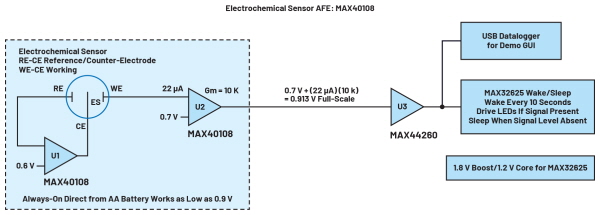
▲그림 1. MAX40108을 채택한 전기화학식 센서의 블록 다이어그램
아래 링크에 연결하면 이 전기화학식 센서의 회로도를 확인할 수 있다.
■ 에탄올 센서 평가
에탄올 센서 평가를 위해서 사용한 센서는 SPEC 3SP_Ethanol_1000 Package 110-202이다(그림 2).
▲그림 2. 에탄올 센서 SPEC 3SP_Ethanol_1000 Package 110-202
이 SPEC 에탄올 센서는 포집한 기체의 양에 비례하여 전류를 발생한다. 이 센서는 3전극(WE, RE, CE) 디바이스이다.
- WE(working electrode: 작업 전극) : WE는 0.7V로 바이어스하고, 기체를 감지하는 역할을 한다.
- RE(reference electrode: 레퍼런스 전극) : RE는 0.6V 바이어스 전압의 안정적인 전기화학 전위를 전해질에 제공하는데, 기체에 노출되지 않는다.
- CE(counter electrode: 상대 전극) : CE는 기체가 존재할 때 전도한다. 전도 수준은 기체의 농도에 비례하는데, 이때 시스템이 이를 전기적으로 측정한다.
이 기체 센서 평가를 위해서는 기체 입자가 SPEC 센서와 물리적으로 접촉해야 한다. 다시 말해 이 에탄올 센서는 센서가 놓여 있는 장소에 존재하는 기체만을 측정한다.
따라서 에탄올이나 CO 같은 기체를 정확하고도 효과적으로 감지하기 위해서는 기체 농도가 확산되는 장소에 센서를 놓아야 한다. 이 시험을 위해서 면봉을 에탄올 용액에다 집어넣었다 뺀 다음에 SPEC 센서 바로 앞에 놓아두었다.
그림 3은 에탄올 기체를 포착한 것을 보여주는데, 파란색 곡선으로 표시된 부분이다. 녹색 선은 마이크로컨트롤러를 포함한 전체 시스템의 전류 소모로서, 90mA 정격이다.
하지만 MAX40108 자체의 전류 소모는 VDD = 0.9V 및 TA = 25 C로 25.5 A에 불과하다(그림 4).
▲그림 3. 에탄올 센서의 성능
▲그림 4. 다양한 전원 전압에서 동작 온도 범위에 걸친 전류 소모
휴지(idle) 모드일 때는, 마이크로컨트롤러가 매 10초마다 기동해서 에탄올 기체를 모니터링한다. 이 기체가 존재하면 마이크로컨트롤러가 기체 농도를 측정한다. 그림에서 파란색 곡선으로 표시된 부분이다. 빨간색 선은 AA 배터리 전압으로서, 약 1.5V이고, 노란색 선은 CE 전압이다.
이 에탄올 센서가 기체 농도에 어떻게 반응하는지 알아보기 위해서 면봉을 센서로부터 좀 떨어진 곳으로 옮겨보았다.
그림 5는 이렇게 해서 측정한 결과를 보여준다. 예상대로 기체 농도를 나타내는 파란색 곡선이 낮아지는 것을 알 수 있다.
▲그림 5. 기체를 묻힌 면봉을 SPEC 센서로부터 떨어진 곳으로 옮긴 후에 에탄올 센서의 성능
■ 일산화탄소 센서 평가
에탄올과 달리 CO는 인체에 유해할 수 있는 기체로서, 휘발유나 심지어는 양초 같은 것이 불완전 연소할 때 발생한다.
CO 기체 시험을 실시할 때는 건강과 안전을 위해 적절한 환기가 필요하다. 이 평가를 위해서 오목한 용기에 양초를 사용해서 CO 기체를 발생하고 앞선 시험과 동일하게 SPEC 3SP_ Ethanol_1000 Package 110-202를 사용해서 CO 기체 농도를 포착했다.
그림 6은 CO 기체를 포착한 것을 나타낸다. 파란색 선은 CO 기체 농도이고, 녹색 선은 마이크로컨트롤러를 포함한 전체 시스템의 전류 소모로서 정격 90mA이다.
에탄올 시험과 마찬가지로, 휴지 모드일 때 마이크로컨트롤러가 매 10초마다 기동해서 CO 기체를 모니터링한다. 이 기체가 감지되면 마이크로컨트롤러가 기체 농도를 측정한다.
그림에서 파란색 곡선으로 표시한 부분이다. 빨간색 선은 AA 배터리 전압으로서 약 1.5V이고, 노란색 선은 CE 전압이다.
▲그림 6. MAX40108을 채택한 CO 센서의 성능
■ 맺음말
컨슈머 및 산업용 애플리케이션에서 에탄올이나 CO 같은 기체를 정확하게 측정하기 위해서는 최저 0.9V의 전원 전압으로 동작하는 저전력 고정밀 연산 증폭기가 필요하다.
MAX40108은 에탄올이나 CO 같은 일상적인 기체를 효과적으로 포착하고 측정할 수 있도록 설계된 것으로서, 25.5 A에 불과한 낮은 전류 소모와 1.22 x 0.92mm 크기의 매우 작은 8볼 WLP 패키지를 특징으로 한다.
또한 이 증폭기 제품은 셧다운 모드를 사용해서 전력 소비를 더욱 줄일 수 있어 웨어러블 기기, 휴대용 의료 기기, 그리고 압력, 유량, 수위, 온도, 근접 감지 같은 산업용 IoT(IIoT)에 사용하기에 적합하다.
※ 저자 소개
톰 오-이엉(Tom Au-Yeung)은 아나로그디바이스(Analog Devices)에서 20년 넘게 재직하고 있다. 믹서, 증폭기, 전력 증폭기, 전압 제어 오실레이터, ADC, DAC 같은 RF/무선 및 아날로그 기술과 관련해서 풍부한 경험을 쌓고 있다. 캘리포니아 폴리테크닉 주립대학 - 샌 루이스 오비스포에서 BSEE 및 산타클라라 대학에서 전기공학 석사학위를 취득했다.

